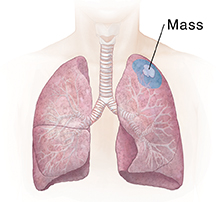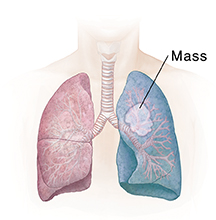Understanding Lung Surgery
Understanding Lung Surgery
Surgery is often done to get a closer look at the inside of the lungs and to help treat lung problems. If a mass is found in the lung, surgery can help determine its cause. If needed, the mass may also be removed. Surgery may be done for other conditions as well, such as a collapsed lung or fluid around the lung.
Wedge resection removes a small part of a lobe. |
Segment resection removes a larger part of a lobe. |
Lobectomy removes an entire lobe. |
Pneumonectomy removes the entire lung. |
A lung mass

A collapsed lung
If part of the lung wall is thin or ruptured, air may leak into the pleural cavity (the space between the lungs and the chest wall). If air collects here, the lung may collapse. This is known as pneumothorax. Tubes placed during surgery can drain air from the pleural cavity so the lung re-expands. During surgery, the wall of the lung can also be fixed so it is less likely to collapse again.
Fluid around the lungs
Fluid may collect in the area around the lungs. One common cause of fluid around the lungs is a lung infection. This may be a complication of certain types of surgery or an illness such as pneumonia. During surgery, chest tubes can be placed in the pleural cavity to drain fluid and help the lungs heal.
Lung reduction surgery
This surgery can be done for some people with emphysema. A part of each lung is removed. This helps to open up the airways, so air can travel through them more freely. Since the size of the lungs is reduced in the chest, the muscle under the lungs (the diaphragm) may have more room to move. This helps get more air in and out with each breath. Lung reduction surgery may reduce symptoms, but it’s not a cure.
Updated:
January 24, 2018
Sources:
Lung volume reduction surgery in COPD. UpToDate, Patient information: Pneumothorax (collapsed lung) (The Basics). UpToDate
Reviewed By:
Gersten, Todd, MD,Stump-Sutliff, Kim, RN, MSN, AOCNS



